University Study: Immune Checkpoint Inhibitors in SCCHN and Biomarkers
VerifiedAdded on 2019/09/16
|16
|4844
|391
Report
AI Summary
This report provides a comprehensive overview of the emerging role of immune checkpoint inhibitors (ICIs) in the treatment of squamous cell carcinoma of the head and neck (SCCHN). It details the mechanisms of ICIs, focusing on PD-1/PD-L1 and CTLA-4 pathways, and their impact on improving survival rates. The report examines key clinical trials, including CheckMate 141, KEYNOTE-040, and HAWK, highlighting the efficacy of nivolumab, pembrolizumab, and durvalumab, respectively. It also explores combination therapies, such as dual immune checkpoint inhibition and the integration of ICIs with viral therapy, chemotherapy, and radiotherapy. Furthermore, the report discusses predictive and prognostic biomarkers, including HPV status, PD-L1 expression, tumor-infiltrating lymphocytes (TILs), and tumor mutation burden, and their roles in guiding treatment decisions and predicting patient outcomes. The report emphasizes the importance of personalized treatment approaches, considering both the benefits and the immune-related adverse effects of ICIs.
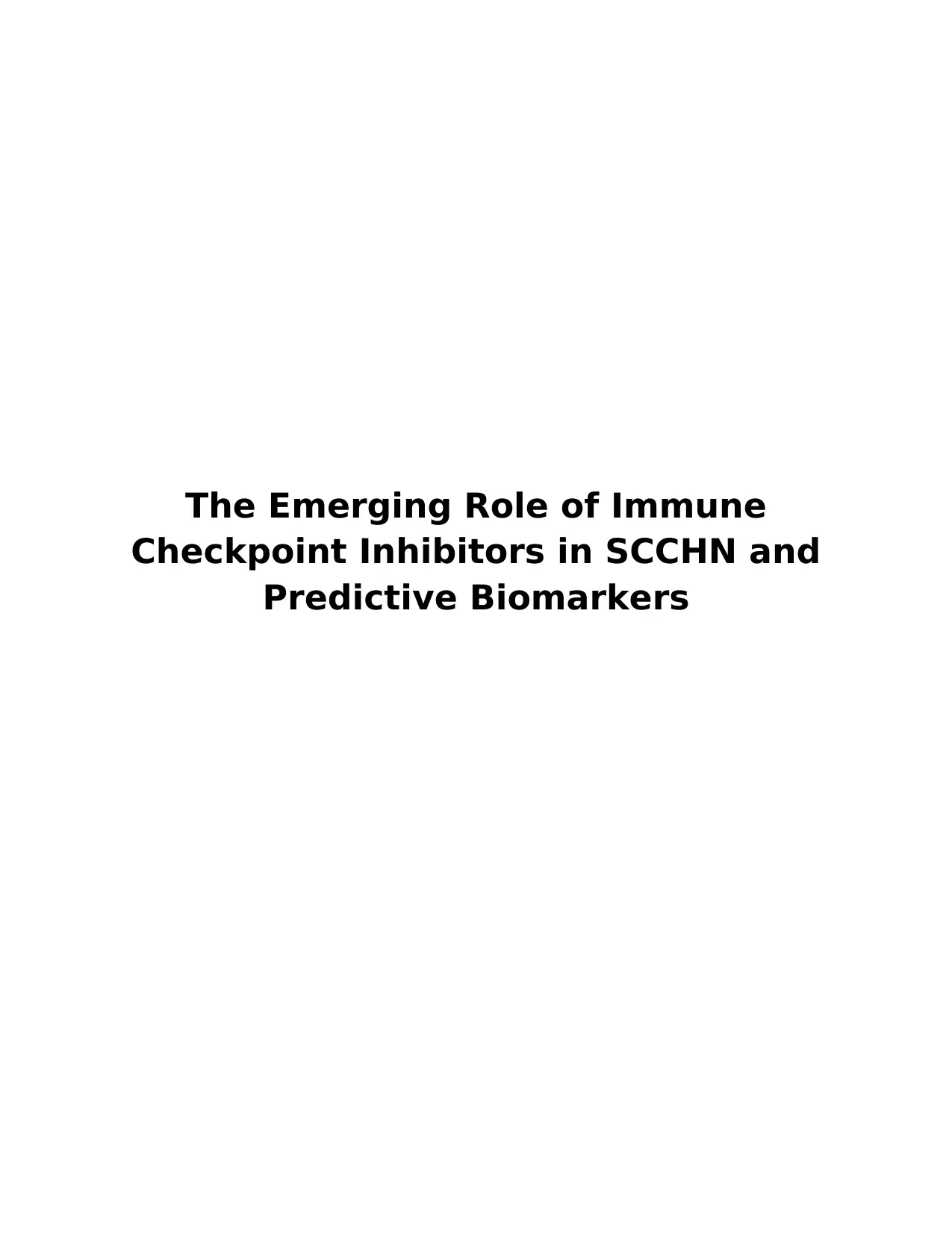
The Emerging Role of Immune
Checkpoint Inhibitors in SCCHN and
Predictive Biomarkers
Checkpoint Inhibitors in SCCHN and
Predictive Biomarkers
Paraphrase This Document
Need a fresh take? Get an instant paraphrase of this document with our AI Paraphraser
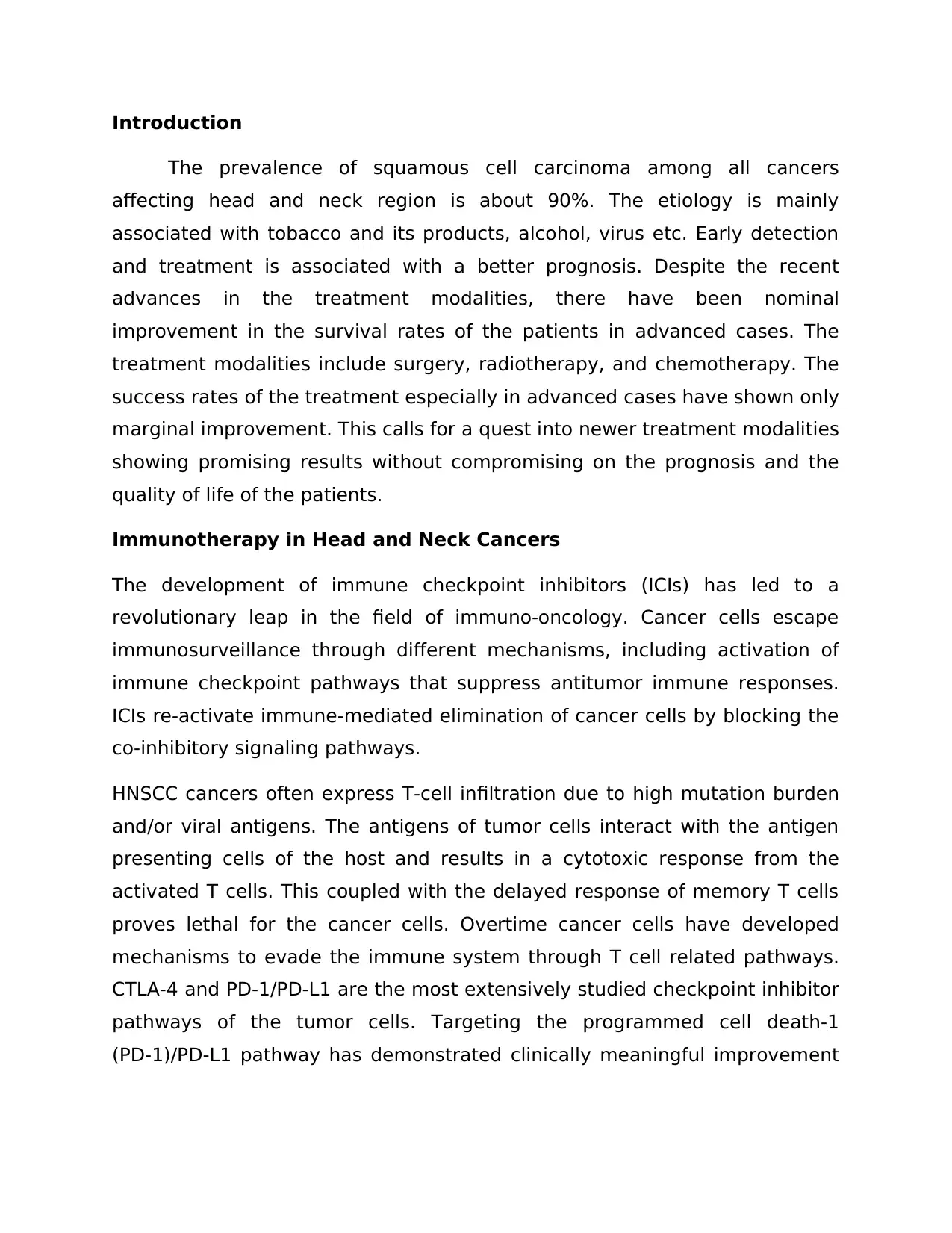
Introduction
The prevalence of squamous cell carcinoma among all cancers
affecting head and neck region is about 90%. The etiology is mainly
associated with tobacco and its products, alcohol, virus etc. Early detection
and treatment is associated with a better prognosis. Despite the recent
advances in the treatment modalities, there have been nominal
improvement in the survival rates of the patients in advanced cases. The
treatment modalities include surgery, radiotherapy, and chemotherapy. The
success rates of the treatment especially in advanced cases have shown only
marginal improvement. This calls for a quest into newer treatment modalities
showing promising results without compromising on the prognosis and the
quality of life of the patients.
Immunotherapy in Head and Neck Cancers
The development of immune checkpoint inhibitors (ICIs) has led to a
revolutionary leap in the field of immuno-oncology. Cancer cells escape
immunosurveillance through different mechanisms, including activation of
immune checkpoint pathways that suppress antitumor immune responses.
ICIs re-activate immune-mediated elimination of cancer cells by blocking the
co-inhibitory signaling pathways.
HNSCC cancers often express T-cell infiltration due to high mutation burden
and/or viral antigens. The antigens of tumor cells interact with the antigen
presenting cells of the host and results in a cytotoxic response from the
activated T cells. This coupled with the delayed response of memory T cells
proves lethal for the cancer cells. Overtime cancer cells have developed
mechanisms to evade the immune system through T cell related pathways.
CTLA-4 and PD-1/PD-L1 are the most extensively studied checkpoint inhibitor
pathways of the tumor cells. Targeting the programmed cell death-1
(PD-1)/PD-L1 pathway has demonstrated clinically meaningful improvement
The prevalence of squamous cell carcinoma among all cancers
affecting head and neck region is about 90%. The etiology is mainly
associated with tobacco and its products, alcohol, virus etc. Early detection
and treatment is associated with a better prognosis. Despite the recent
advances in the treatment modalities, there have been nominal
improvement in the survival rates of the patients in advanced cases. The
treatment modalities include surgery, radiotherapy, and chemotherapy. The
success rates of the treatment especially in advanced cases have shown only
marginal improvement. This calls for a quest into newer treatment modalities
showing promising results without compromising on the prognosis and the
quality of life of the patients.
Immunotherapy in Head and Neck Cancers
The development of immune checkpoint inhibitors (ICIs) has led to a
revolutionary leap in the field of immuno-oncology. Cancer cells escape
immunosurveillance through different mechanisms, including activation of
immune checkpoint pathways that suppress antitumor immune responses.
ICIs re-activate immune-mediated elimination of cancer cells by blocking the
co-inhibitory signaling pathways.
HNSCC cancers often express T-cell infiltration due to high mutation burden
and/or viral antigens. The antigens of tumor cells interact with the antigen
presenting cells of the host and results in a cytotoxic response from the
activated T cells. This coupled with the delayed response of memory T cells
proves lethal for the cancer cells. Overtime cancer cells have developed
mechanisms to evade the immune system through T cell related pathways.
CTLA-4 and PD-1/PD-L1 are the most extensively studied checkpoint inhibitor
pathways of the tumor cells. Targeting the programmed cell death-1
(PD-1)/PD-L1 pathway has demonstrated clinically meaningful improvement
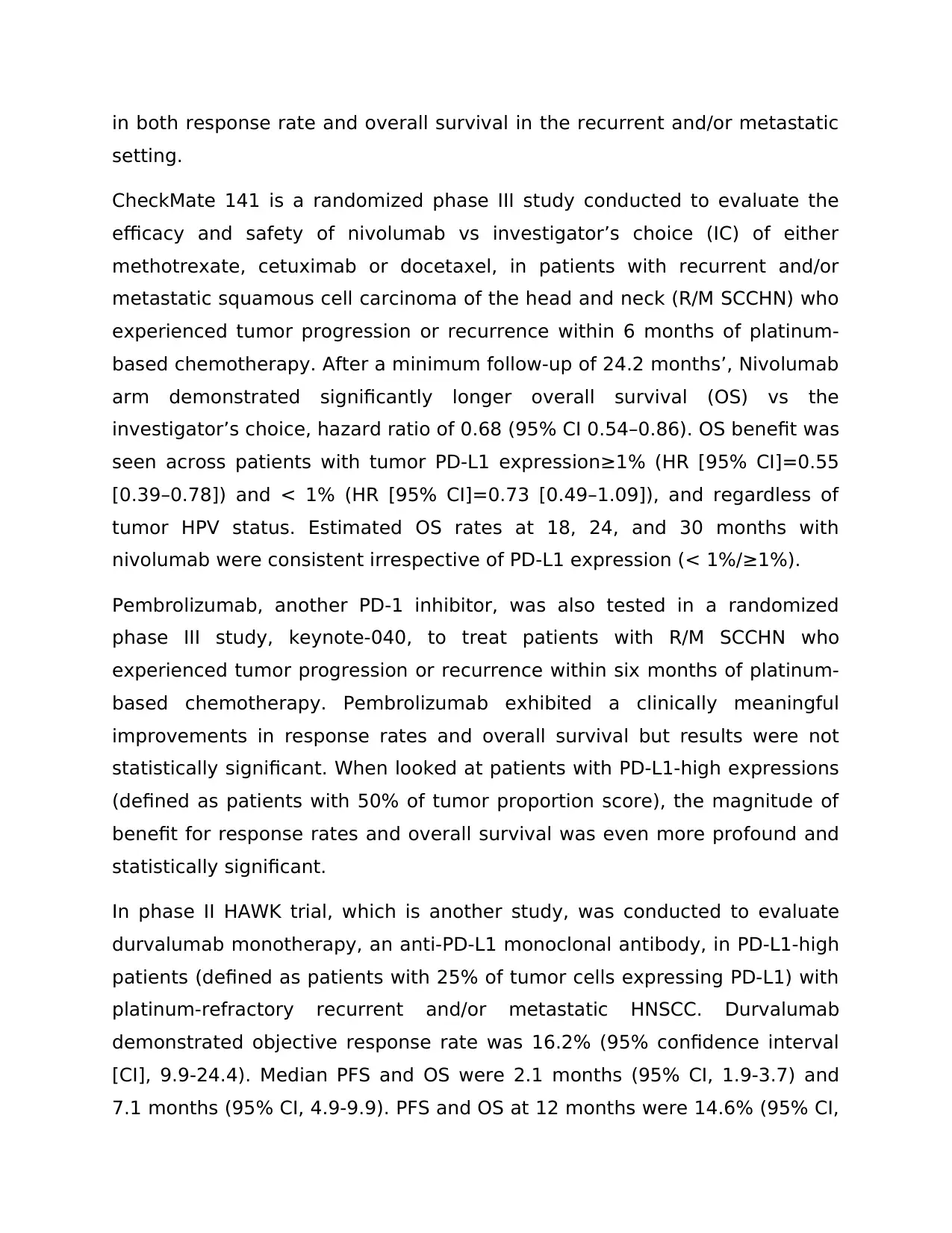
in both response rate and overall survival in the recurrent and/or metastatic
setting.
CheckMate 141 is a randomized phase III study conducted to evaluate the
efficacy and safety of nivolumab vs investigator’s choice (IC) of either
methotrexate, cetuximab or docetaxel, in patients with recurrent and/or
metastatic squamous cell carcinoma of the head and neck (R/M SCCHN) who
experienced tumor progression or recurrence within 6 months of platinum-
based chemotherapy. After a minimum follow-up of 24.2 months’, Nivolumab
arm demonstrated significantly longer overall survival (OS) vs the
investigator’s choice, hazard ratio of 0.68 (95% CI 0.54–0.86). OS benefit was
seen across patients with tumor PD-L1 expression≥1% (HR [95% CI]=0.55
[0.39–0.78]) and < 1% (HR [95% CI]=0.73 [0.49–1.09]), and regardless of
tumor HPV status. Estimated OS rates at 18, 24, and 30 months with
nivolumab were consistent irrespective of PD-L1 expression (< 1%/≥1%).
Pembrolizumab, another PD-1 inhibitor, was also tested in a randomized
phase III study, keynote-040, to treat patients with R/M SCCHN who
experienced tumor progression or recurrence within six months of platinum-
based chemotherapy. Pembrolizumab exhibited a clinically meaningful
improvements in response rates and overall survival but results were not
statistically significant. When looked at patients with PD-L1-high expressions
(defined as patients with 50% of tumor proportion score), the magnitude of
benefit for response rates and overall survival was even more profound and
statistically significant.
In phase II HAWK trial, which is another study, was conducted to evaluate
durvalumab monotherapy, an anti-PD-L1 monoclonal antibody, in PD-L1-high
patients (defined as patients with 25% of tumor cells expressing PD-L1) with
platinum-refractory recurrent and/or metastatic HNSCC. Durvalumab
demonstrated objective response rate was 16.2% (95% confidence interval
[CI], 9.9-24.4). Median PFS and OS were 2.1 months (95% CI, 1.9-3.7) and
7.1 months (95% CI, 4.9-9.9). PFS and OS at 12 months were 14.6% (95% CI,
setting.
CheckMate 141 is a randomized phase III study conducted to evaluate the
efficacy and safety of nivolumab vs investigator’s choice (IC) of either
methotrexate, cetuximab or docetaxel, in patients with recurrent and/or
metastatic squamous cell carcinoma of the head and neck (R/M SCCHN) who
experienced tumor progression or recurrence within 6 months of platinum-
based chemotherapy. After a minimum follow-up of 24.2 months’, Nivolumab
arm demonstrated significantly longer overall survival (OS) vs the
investigator’s choice, hazard ratio of 0.68 (95% CI 0.54–0.86). OS benefit was
seen across patients with tumor PD-L1 expression≥1% (HR [95% CI]=0.55
[0.39–0.78]) and < 1% (HR [95% CI]=0.73 [0.49–1.09]), and regardless of
tumor HPV status. Estimated OS rates at 18, 24, and 30 months with
nivolumab were consistent irrespective of PD-L1 expression (< 1%/≥1%).
Pembrolizumab, another PD-1 inhibitor, was also tested in a randomized
phase III study, keynote-040, to treat patients with R/M SCCHN who
experienced tumor progression or recurrence within six months of platinum-
based chemotherapy. Pembrolizumab exhibited a clinically meaningful
improvements in response rates and overall survival but results were not
statistically significant. When looked at patients with PD-L1-high expressions
(defined as patients with 50% of tumor proportion score), the magnitude of
benefit for response rates and overall survival was even more profound and
statistically significant.
In phase II HAWK trial, which is another study, was conducted to evaluate
durvalumab monotherapy, an anti-PD-L1 monoclonal antibody, in PD-L1-high
patients (defined as patients with 25% of tumor cells expressing PD-L1) with
platinum-refractory recurrent and/or metastatic HNSCC. Durvalumab
demonstrated objective response rate was 16.2% (95% confidence interval
[CI], 9.9-24.4). Median PFS and OS were 2.1 months (95% CI, 1.9-3.7) and
7.1 months (95% CI, 4.9-9.9). PFS and OS at 12 months were 14.6% (95% CI,
⊘ This is a preview!⊘
Do you want full access?
Subscribe today to unlock all pages.

Trusted by 1+ million students worldwide
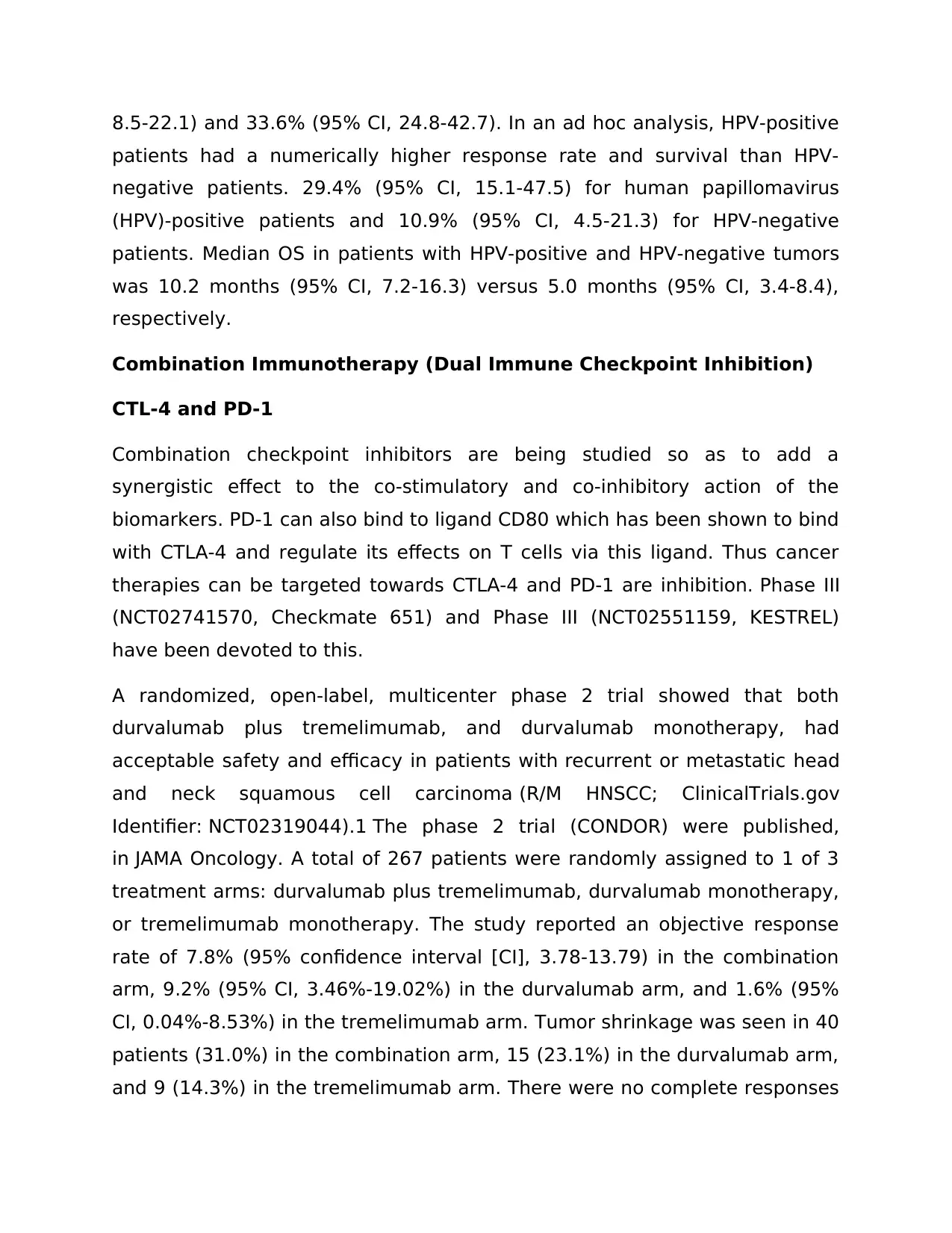
8.5-22.1) and 33.6% (95% CI, 24.8-42.7). In an ad hoc analysis, HPV-positive
patients had a numerically higher response rate and survival than HPV-
negative patients. 29.4% (95% CI, 15.1-47.5) for human papillomavirus
(HPV)-positive patients and 10.9% (95% CI, 4.5-21.3) for HPV-negative
patients. Median OS in patients with HPV-positive and HPV-negative tumors
was 10.2 months (95% CI, 7.2-16.3) versus 5.0 months (95% CI, 3.4-8.4),
respectively.
Combination Immunotherapy (Dual Immune Checkpoint Inhibition)
CTL-4 and PD-1
Combination checkpoint inhibitors are being studied so as to add a
synergistic effect to the co-stimulatory and co-inhibitory action of the
biomarkers. PD-1 can also bind to ligand CD80 which has been shown to bind
with CTLA-4 and regulate its effects on T cells via this ligand. Thus cancer
therapies can be targeted towards CTLA-4 and PD-1 are inhibition. Phase III
(NCT02741570, Checkmate 651) and Phase III (NCT02551159, KESTREL)
have been devoted to this.
A randomized, open-label, multicenter phase 2 trial showed that both
durvalumab plus tremelimumab, and durvalumab monotherapy, had
acceptable safety and efficacy in patients with recurrent or metastatic head
and neck squamous cell carcinoma (R/M HNSCC; ClinicalTrials.gov
Identifier: NCT02319044).1 The phase 2 trial (CONDOR) were published,
in JAMA Oncology. A total of 267 patients were randomly assigned to 1 of 3
treatment arms: durvalumab plus tremelimumab, durvalumab monotherapy,
or tremelimumab monotherapy. The study reported an objective response
rate of 7.8% (95% confidence interval [CI], 3.78-13.79) in the combination
arm, 9.2% (95% CI, 3.46%-19.02%) in the durvalumab arm, and 1.6% (95%
CI, 0.04%-8.53%) in the tremelimumab arm. Tumor shrinkage was seen in 40
patients (31.0%) in the combination arm, 15 (23.1%) in the durvalumab arm,
and 9 (14.3%) in the tremelimumab arm. There were no complete responses
patients had a numerically higher response rate and survival than HPV-
negative patients. 29.4% (95% CI, 15.1-47.5) for human papillomavirus
(HPV)-positive patients and 10.9% (95% CI, 4.5-21.3) for HPV-negative
patients. Median OS in patients with HPV-positive and HPV-negative tumors
was 10.2 months (95% CI, 7.2-16.3) versus 5.0 months (95% CI, 3.4-8.4),
respectively.
Combination Immunotherapy (Dual Immune Checkpoint Inhibition)
CTL-4 and PD-1
Combination checkpoint inhibitors are being studied so as to add a
synergistic effect to the co-stimulatory and co-inhibitory action of the
biomarkers. PD-1 can also bind to ligand CD80 which has been shown to bind
with CTLA-4 and regulate its effects on T cells via this ligand. Thus cancer
therapies can be targeted towards CTLA-4 and PD-1 are inhibition. Phase III
(NCT02741570, Checkmate 651) and Phase III (NCT02551159, KESTREL)
have been devoted to this.
A randomized, open-label, multicenter phase 2 trial showed that both
durvalumab plus tremelimumab, and durvalumab monotherapy, had
acceptable safety and efficacy in patients with recurrent or metastatic head
and neck squamous cell carcinoma (R/M HNSCC; ClinicalTrials.gov
Identifier: NCT02319044).1 The phase 2 trial (CONDOR) were published,
in JAMA Oncology. A total of 267 patients were randomly assigned to 1 of 3
treatment arms: durvalumab plus tremelimumab, durvalumab monotherapy,
or tremelimumab monotherapy. The study reported an objective response
rate of 7.8% (95% confidence interval [CI], 3.78-13.79) in the combination
arm, 9.2% (95% CI, 3.46%-19.02%) in the durvalumab arm, and 1.6% (95%
CI, 0.04%-8.53%) in the tremelimumab arm. Tumor shrinkage was seen in 40
patients (31.0%) in the combination arm, 15 (23.1%) in the durvalumab arm,
and 9 (14.3%) in the tremelimumab arm. There were no complete responses
Paraphrase This Document
Need a fresh take? Get an instant paraphrase of this document with our AI Paraphraser
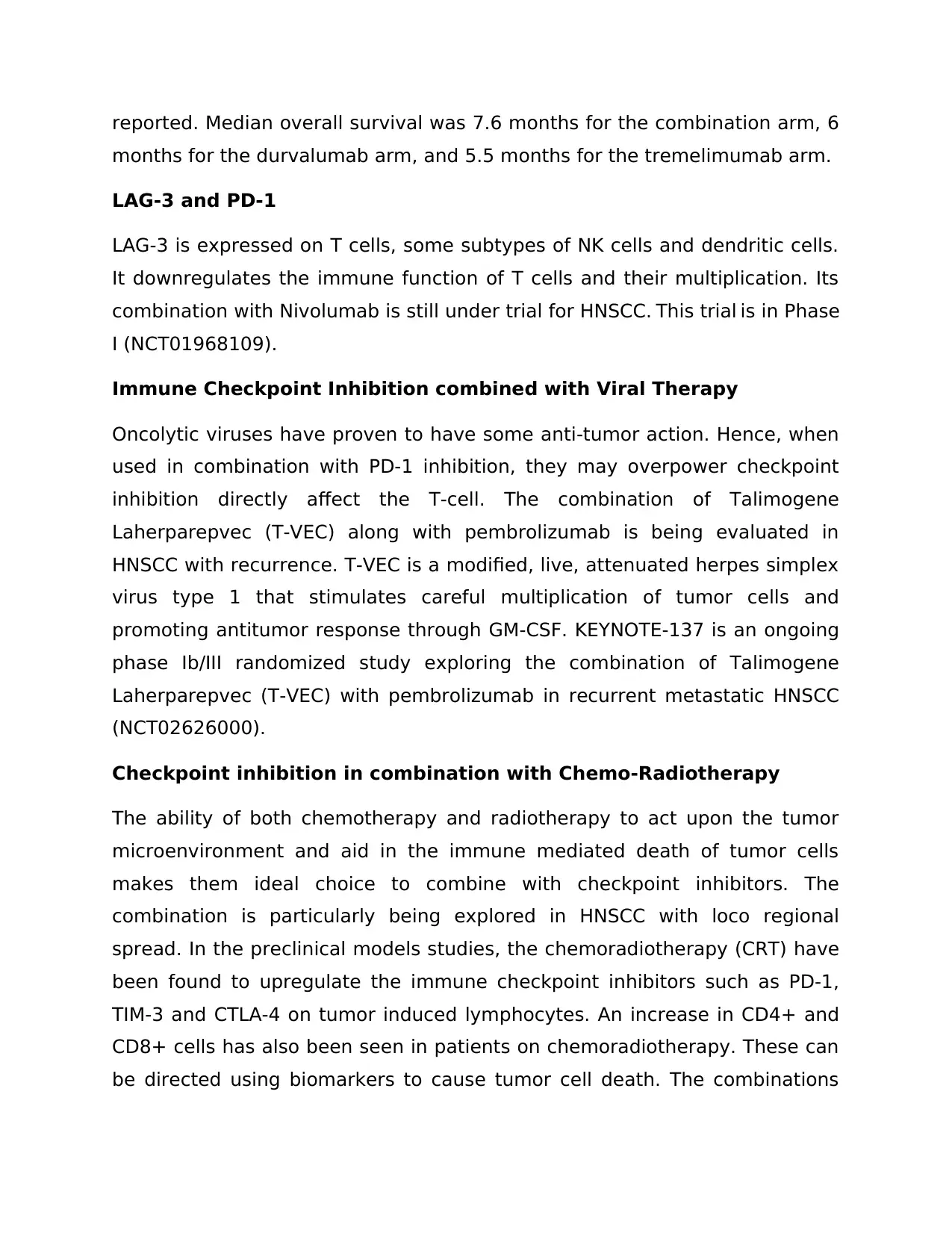
reported. Median overall survival was 7.6 months for the combination arm, 6
months for the durvalumab arm, and 5.5 months for the tremelimumab arm.
LAG-3 and PD-1
LAG-3 is expressed on T cells, some subtypes of NK cells and dendritic cells.
It downregulates the immune function of T cells and their multiplication. Its
combination with Nivolumab is still under trial for HNSCC. This trial is in Phase
I (NCT01968109).
Immune Checkpoint Inhibition combined with Viral Therapy
Oncolytic viruses have proven to have some anti-tumor action. Hence, when
used in combination with PD-1 inhibition, they may overpower checkpoint
inhibition directly affect the T-cell. The combination of Talimogene
Laherparepvec (T-VEC) along with pembrolizumab is being evaluated in
HNSCC with recurrence. T-VEC is a modified, live, attenuated herpes simplex
virus type 1 that stimulates careful multiplication of tumor cells and
promoting antitumor response through GM-CSF. KEYNOTE-137 is an ongoing
phase Ib/III randomized study exploring the combination of Talimogene
Laherparepvec (T-VEC) with pembrolizumab in recurrent metastatic HNSCC
(NCT02626000).
Checkpoint inhibition in combination with Chemo-Radiotherapy
The ability of both chemotherapy and radiotherapy to act upon the tumor
microenvironment and aid in the immune mediated death of tumor cells
makes them ideal choice to combine with checkpoint inhibitors. The
combination is particularly being explored in HNSCC with loco regional
spread. In the preclinical models studies, the chemoradiotherapy (CRT) have
been found to upregulate the immune checkpoint inhibitors such as PD-1,
TIM-3 and CTLA-4 on tumor induced lymphocytes. An increase in CD4+ and
CD8+ cells has also been seen in patients on chemoradiotherapy. These can
be directed using biomarkers to cause tumor cell death. The combinations
months for the durvalumab arm, and 5.5 months for the tremelimumab arm.
LAG-3 and PD-1
LAG-3 is expressed on T cells, some subtypes of NK cells and dendritic cells.
It downregulates the immune function of T cells and their multiplication. Its
combination with Nivolumab is still under trial for HNSCC. This trial is in Phase
I (NCT01968109).
Immune Checkpoint Inhibition combined with Viral Therapy
Oncolytic viruses have proven to have some anti-tumor action. Hence, when
used in combination with PD-1 inhibition, they may overpower checkpoint
inhibition directly affect the T-cell. The combination of Talimogene
Laherparepvec (T-VEC) along with pembrolizumab is being evaluated in
HNSCC with recurrence. T-VEC is a modified, live, attenuated herpes simplex
virus type 1 that stimulates careful multiplication of tumor cells and
promoting antitumor response through GM-CSF. KEYNOTE-137 is an ongoing
phase Ib/III randomized study exploring the combination of Talimogene
Laherparepvec (T-VEC) with pembrolizumab in recurrent metastatic HNSCC
(NCT02626000).
Checkpoint inhibition in combination with Chemo-Radiotherapy
The ability of both chemotherapy and radiotherapy to act upon the tumor
microenvironment and aid in the immune mediated death of tumor cells
makes them ideal choice to combine with checkpoint inhibitors. The
combination is particularly being explored in HNSCC with loco regional
spread. In the preclinical models studies, the chemoradiotherapy (CRT) have
been found to upregulate the immune checkpoint inhibitors such as PD-1,
TIM-3 and CTLA-4 on tumor induced lymphocytes. An increase in CD4+ and
CD8+ cells has also been seen in patients on chemoradiotherapy. These can
be directed using biomarkers to cause tumor cell death. The combinations
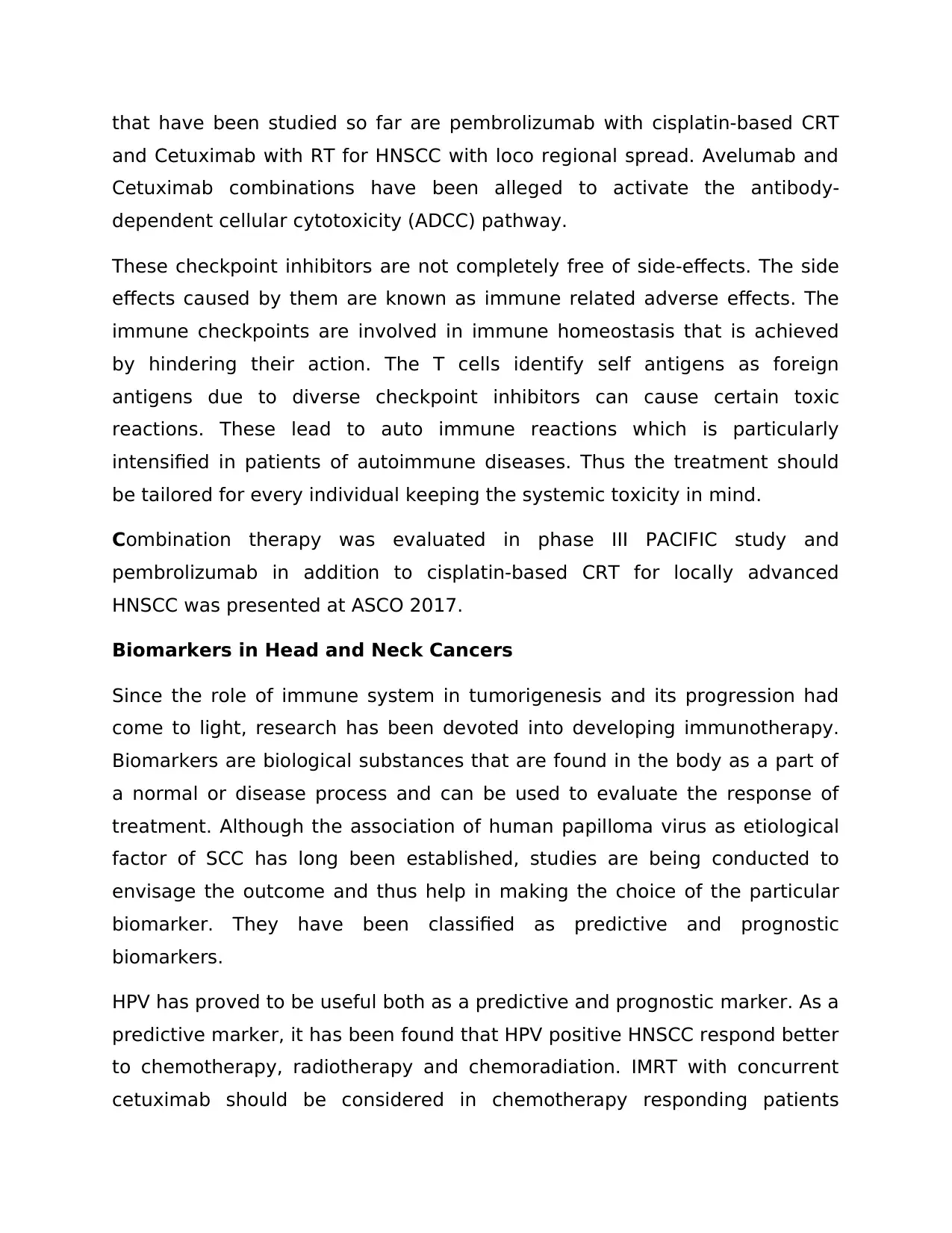
that have been studied so far are pembrolizumab with cisplatin-based CRT
and Cetuximab with RT for HNSCC with loco regional spread. Avelumab and
Cetuximab combinations have been alleged to activate the antibody-
dependent cellular cytotoxicity (ADCC) pathway.
These checkpoint inhibitors are not completely free of side-effects. The side
effects caused by them are known as immune related adverse effects. The
immune checkpoints are involved in immune homeostasis that is achieved
by hindering their action. The T cells identify self antigens as foreign
antigens due to diverse checkpoint inhibitors can cause certain toxic
reactions. These lead to auto immune reactions which is particularly
intensified in patients of autoimmune diseases. Thus the treatment should
be tailored for every individual keeping the systemic toxicity in mind.
Combination therapy was evaluated in phase III PACIFIC study and
pembrolizumab in addition to cisplatin-based CRT for locally advanced
HNSCC was presented at ASCO 2017.
Biomarkers in Head and Neck Cancers
Since the role of immune system in tumorigenesis and its progression had
come to light, research has been devoted into developing immunotherapy.
Biomarkers are biological substances that are found in the body as a part of
a normal or disease process and can be used to evaluate the response of
treatment. Although the association of human papilloma virus as etiological
factor of SCC has long been established, studies are being conducted to
envisage the outcome and thus help in making the choice of the particular
biomarker. They have been classified as predictive and prognostic
biomarkers.
HPV has proved to be useful both as a predictive and prognostic marker. As a
predictive marker, it has been found that HPV positive HNSCC respond better
to chemotherapy, radiotherapy and chemoradiation. IMRT with concurrent
cetuximab should be considered in chemotherapy responding patients
and Cetuximab with RT for HNSCC with loco regional spread. Avelumab and
Cetuximab combinations have been alleged to activate the antibody-
dependent cellular cytotoxicity (ADCC) pathway.
These checkpoint inhibitors are not completely free of side-effects. The side
effects caused by them are known as immune related adverse effects. The
immune checkpoints are involved in immune homeostasis that is achieved
by hindering their action. The T cells identify self antigens as foreign
antigens due to diverse checkpoint inhibitors can cause certain toxic
reactions. These lead to auto immune reactions which is particularly
intensified in patients of autoimmune diseases. Thus the treatment should
be tailored for every individual keeping the systemic toxicity in mind.
Combination therapy was evaluated in phase III PACIFIC study and
pembrolizumab in addition to cisplatin-based CRT for locally advanced
HNSCC was presented at ASCO 2017.
Biomarkers in Head and Neck Cancers
Since the role of immune system in tumorigenesis and its progression had
come to light, research has been devoted into developing immunotherapy.
Biomarkers are biological substances that are found in the body as a part of
a normal or disease process and can be used to evaluate the response of
treatment. Although the association of human papilloma virus as etiological
factor of SCC has long been established, studies are being conducted to
envisage the outcome and thus help in making the choice of the particular
biomarker. They have been classified as predictive and prognostic
biomarkers.
HPV has proved to be useful both as a predictive and prognostic marker. As a
predictive marker, it has been found that HPV positive HNSCC respond better
to chemotherapy, radiotherapy and chemoradiation. IMRT with concurrent
cetuximab should be considered in chemotherapy responding patients
⊘ This is a preview!⊘
Do you want full access?
Subscribe today to unlock all pages.

Trusted by 1+ million students worldwide
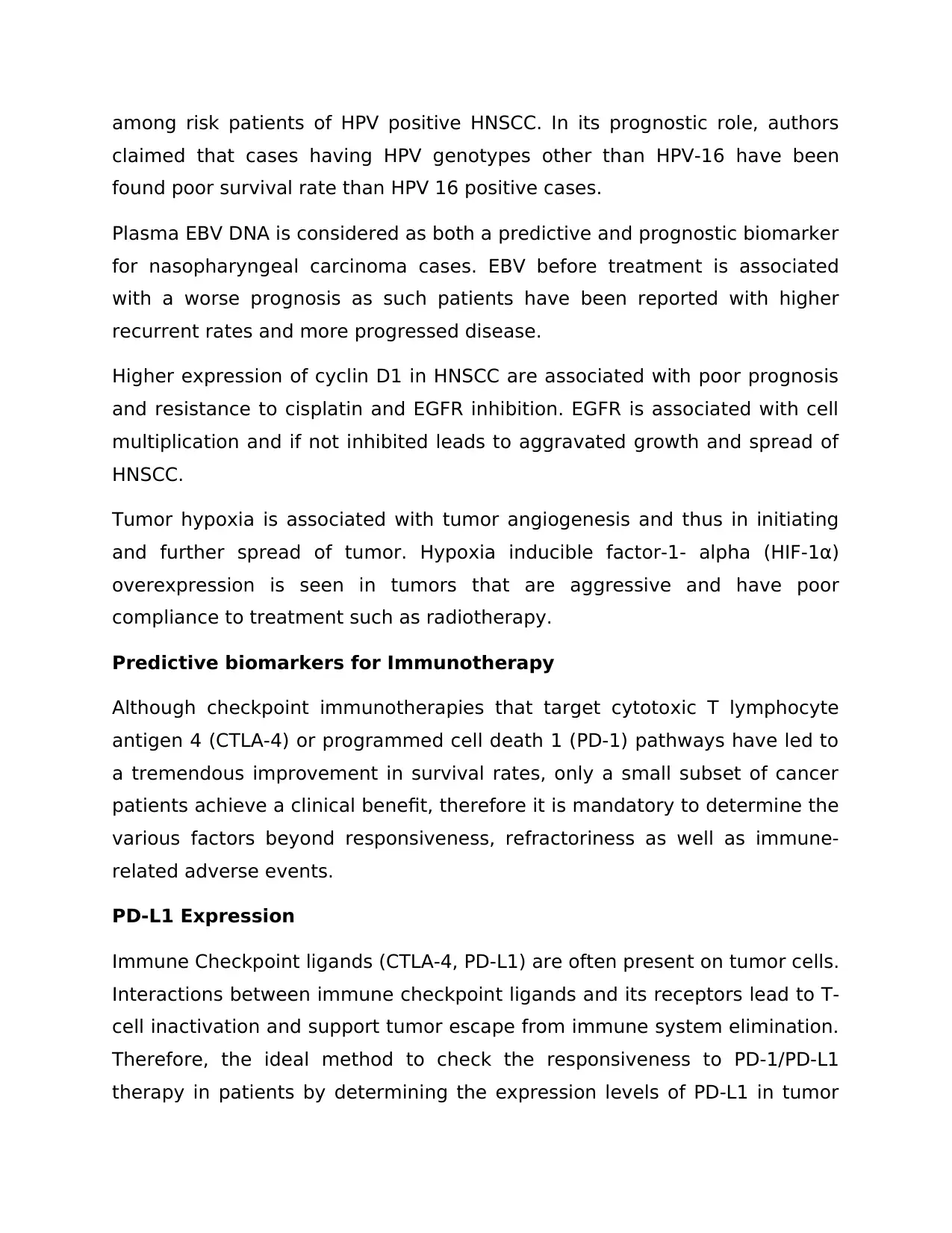
among risk patients of HPV positive HNSCC. In its prognostic role, authors
claimed that cases having HPV genotypes other than HPV-16 have been
found poor survival rate than HPV 16 positive cases.
Plasma EBV DNA is considered as both a predictive and prognostic biomarker
for nasopharyngeal carcinoma cases. EBV before treatment is associated
with a worse prognosis as such patients have been reported with higher
recurrent rates and more progressed disease.
Higher expression of cyclin D1 in HNSCC are associated with poor prognosis
and resistance to cisplatin and EGFR inhibition. EGFR is associated with cell
multiplication and if not inhibited leads to aggravated growth and spread of
HNSCC.
Tumor hypoxia is associated with tumor angiogenesis and thus in initiating
and further spread of tumor. Hypoxia inducible factor-1- alpha (HIF-1α)
overexpression is seen in tumors that are aggressive and have poor
compliance to treatment such as radiotherapy.
Predictive biomarkers for Immunotherapy
Although checkpoint immunotherapies that target cytotoxic T lymphocyte
antigen 4 (CTLA-4) or programmed cell death 1 (PD-1) pathways have led to
a tremendous improvement in survival rates, only a small subset of cancer
patients achieve a clinical benefit, therefore it is mandatory to determine the
various factors beyond responsiveness, refractoriness as well as immune-
related adverse events.
PD-L1 Expression
Immune Checkpoint ligands (CTLA-4, PD-L1) are often present on tumor cells.
Interactions between immune checkpoint ligands and its receptors lead to T-
cell inactivation and support tumor escape from immune system elimination.
Therefore, the ideal method to check the responsiveness to PD-1/PD-L1
therapy in patients by determining the expression levels of PD-L1 in tumor
claimed that cases having HPV genotypes other than HPV-16 have been
found poor survival rate than HPV 16 positive cases.
Plasma EBV DNA is considered as both a predictive and prognostic biomarker
for nasopharyngeal carcinoma cases. EBV before treatment is associated
with a worse prognosis as such patients have been reported with higher
recurrent rates and more progressed disease.
Higher expression of cyclin D1 in HNSCC are associated with poor prognosis
and resistance to cisplatin and EGFR inhibition. EGFR is associated with cell
multiplication and if not inhibited leads to aggravated growth and spread of
HNSCC.
Tumor hypoxia is associated with tumor angiogenesis and thus in initiating
and further spread of tumor. Hypoxia inducible factor-1- alpha (HIF-1α)
overexpression is seen in tumors that are aggressive and have poor
compliance to treatment such as radiotherapy.
Predictive biomarkers for Immunotherapy
Although checkpoint immunotherapies that target cytotoxic T lymphocyte
antigen 4 (CTLA-4) or programmed cell death 1 (PD-1) pathways have led to
a tremendous improvement in survival rates, only a small subset of cancer
patients achieve a clinical benefit, therefore it is mandatory to determine the
various factors beyond responsiveness, refractoriness as well as immune-
related adverse events.
PD-L1 Expression
Immune Checkpoint ligands (CTLA-4, PD-L1) are often present on tumor cells.
Interactions between immune checkpoint ligands and its receptors lead to T-
cell inactivation and support tumor escape from immune system elimination.
Therefore, the ideal method to check the responsiveness to PD-1/PD-L1
therapy in patients by determining the expression levels of PD-L1 in tumor
Paraphrase This Document
Need a fresh take? Get an instant paraphrase of this document with our AI Paraphraser
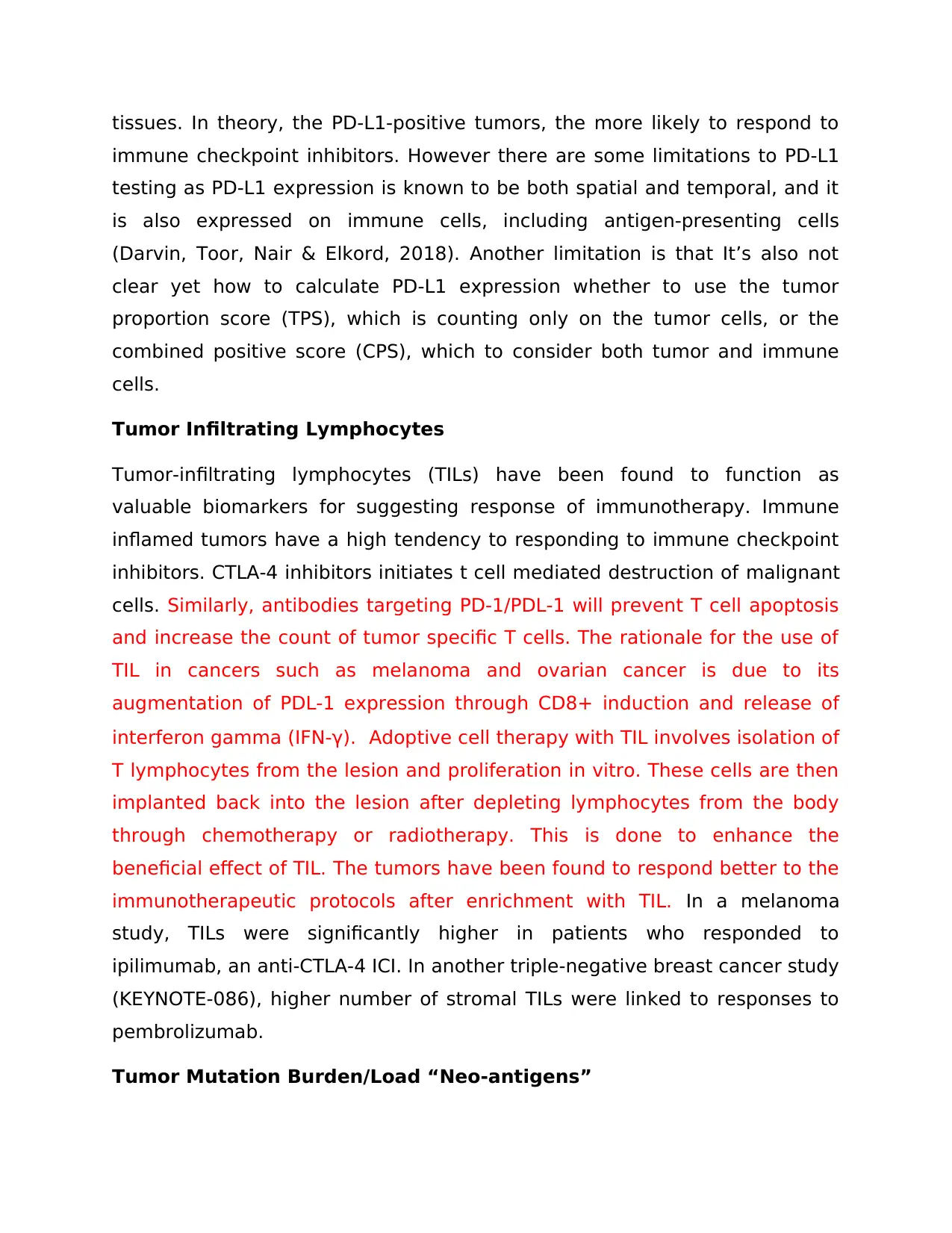
tissues. In theory, the PD-L1-positive tumors, the more likely to respond to
immune checkpoint inhibitors. However there are some limitations to PD-L1
testing as PD-L1 expression is known to be both spatial and temporal, and it
is also expressed on immune cells, including antigen-presenting cells
(Darvin, Toor, Nair & Elkord, 2018). Another limitation is that It’s also not
clear yet how to calculate PD-L1 expression whether to use the tumor
proportion score (TPS), which is counting only on the tumor cells, or the
combined positive score (CPS), which to consider both tumor and immune
cells.
Tumor Infiltrating Lymphocytes
Tumor-infiltrating lymphocytes (TILs) have been found to function as
valuable biomarkers for suggesting response of immunotherapy. Immune
inflamed tumors have a high tendency to responding to immune checkpoint
inhibitors. CTLA-4 inhibitors initiates t cell mediated destruction of malignant
cells. Similarly, antibodies targeting PD-1/PDL-1 will prevent T cell apoptosis
and increase the count of tumor specific T cells. The rationale for the use of
TIL in cancers such as melanoma and ovarian cancer is due to its
augmentation of PDL-1 expression through CD8+ induction and release of
interferon gamma (IFN-γ). Adoptive cell therapy with TIL involves isolation of
T lymphocytes from the lesion and proliferation in vitro. These cells are then
implanted back into the lesion after depleting lymphocytes from the body
through chemotherapy or radiotherapy. This is done to enhance the
beneficial effect of TIL. The tumors have been found to respond better to the
immunotherapeutic protocols after enrichment with TIL. In a melanoma
study, TILs were significantly higher in patients who responded to
ipilimumab, an anti-CTLA-4 ICI. In another triple-negative breast cancer study
(KEYNOTE-086), higher number of stromal TILs were linked to responses to
pembrolizumab.
Tumor Mutation Burden/Load “Neo-antigens”
immune checkpoint inhibitors. However there are some limitations to PD-L1
testing as PD-L1 expression is known to be both spatial and temporal, and it
is also expressed on immune cells, including antigen-presenting cells
(Darvin, Toor, Nair & Elkord, 2018). Another limitation is that It’s also not
clear yet how to calculate PD-L1 expression whether to use the tumor
proportion score (TPS), which is counting only on the tumor cells, or the
combined positive score (CPS), which to consider both tumor and immune
cells.
Tumor Infiltrating Lymphocytes
Tumor-infiltrating lymphocytes (TILs) have been found to function as
valuable biomarkers for suggesting response of immunotherapy. Immune
inflamed tumors have a high tendency to responding to immune checkpoint
inhibitors. CTLA-4 inhibitors initiates t cell mediated destruction of malignant
cells. Similarly, antibodies targeting PD-1/PDL-1 will prevent T cell apoptosis
and increase the count of tumor specific T cells. The rationale for the use of
TIL in cancers such as melanoma and ovarian cancer is due to its
augmentation of PDL-1 expression through CD8+ induction and release of
interferon gamma (IFN-γ). Adoptive cell therapy with TIL involves isolation of
T lymphocytes from the lesion and proliferation in vitro. These cells are then
implanted back into the lesion after depleting lymphocytes from the body
through chemotherapy or radiotherapy. This is done to enhance the
beneficial effect of TIL. The tumors have been found to respond better to the
immunotherapeutic protocols after enrichment with TIL. In a melanoma
study, TILs were significantly higher in patients who responded to
ipilimumab, an anti-CTLA-4 ICI. In another triple-negative breast cancer study
(KEYNOTE-086), higher number of stromal TILs were linked to responses to
pembrolizumab.
Tumor Mutation Burden/Load “Neo-antigens”
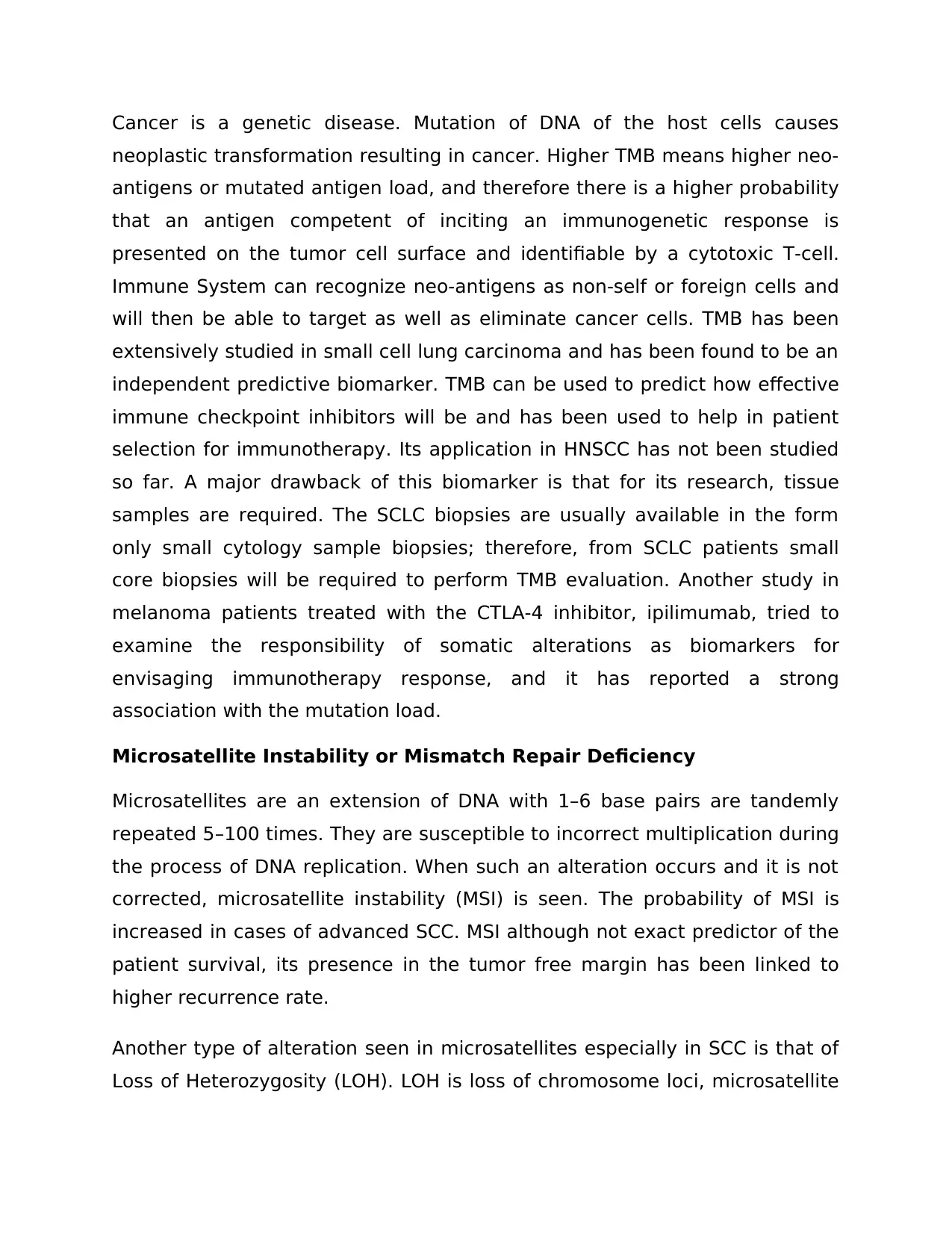
Cancer is a genetic disease. Mutation of DNA of the host cells causes
neoplastic transformation resulting in cancer. Higher TMB means higher neo-
antigens or mutated antigen load, and therefore there is a higher probability
that an antigen competent of inciting an immunogenetic response is
presented on the tumor cell surface and identifiable by a cytotoxic T-cell.
Immune System can recognize neo-antigens as non-self or foreign cells and
will then be able to target as well as eliminate cancer cells. TMB has been
extensively studied in small cell lung carcinoma and has been found to be an
independent predictive biomarker. TMB can be used to predict how effective
immune checkpoint inhibitors will be and has been used to help in patient
selection for immunotherapy. Its application in HNSCC has not been studied
so far. A major drawback of this biomarker is that for its research, tissue
samples are required. The SCLC biopsies are usually available in the form
only small cytology sample biopsies; therefore, from SCLC patients small
core biopsies will be required to perform TMB evaluation. Another study in
melanoma patients treated with the CTLA-4 inhibitor, ipilimumab, tried to
examine the responsibility of somatic alterations as biomarkers for
envisaging immunotherapy response, and it has reported a strong
association with the mutation load.
Microsatellite Instability or Mismatch Repair Deficiency
Microsatellites are an extension of DNA with 1–6 base pairs are tandemly
repeated 5–100 times. They are susceptible to incorrect multiplication during
the process of DNA replication. When such an alteration occurs and it is not
corrected, microsatellite instability (MSI) is seen. The probability of MSI is
increased in cases of advanced SCC. MSI although not exact predictor of the
patient survival, its presence in the tumor free margin has been linked to
higher recurrence rate.
Another type of alteration seen in microsatellites especially in SCC is that of
Loss of Heterozygosity (LOH). LOH is loss of chromosome loci, microsatellite
neoplastic transformation resulting in cancer. Higher TMB means higher neo-
antigens or mutated antigen load, and therefore there is a higher probability
that an antigen competent of inciting an immunogenetic response is
presented on the tumor cell surface and identifiable by a cytotoxic T-cell.
Immune System can recognize neo-antigens as non-self or foreign cells and
will then be able to target as well as eliminate cancer cells. TMB has been
extensively studied in small cell lung carcinoma and has been found to be an
independent predictive biomarker. TMB can be used to predict how effective
immune checkpoint inhibitors will be and has been used to help in patient
selection for immunotherapy. Its application in HNSCC has not been studied
so far. A major drawback of this biomarker is that for its research, tissue
samples are required. The SCLC biopsies are usually available in the form
only small cytology sample biopsies; therefore, from SCLC patients small
core biopsies will be required to perform TMB evaluation. Another study in
melanoma patients treated with the CTLA-4 inhibitor, ipilimumab, tried to
examine the responsibility of somatic alterations as biomarkers for
envisaging immunotherapy response, and it has reported a strong
association with the mutation load.
Microsatellite Instability or Mismatch Repair Deficiency
Microsatellites are an extension of DNA with 1–6 base pairs are tandemly
repeated 5–100 times. They are susceptible to incorrect multiplication during
the process of DNA replication. When such an alteration occurs and it is not
corrected, microsatellite instability (MSI) is seen. The probability of MSI is
increased in cases of advanced SCC. MSI although not exact predictor of the
patient survival, its presence in the tumor free margin has been linked to
higher recurrence rate.
Another type of alteration seen in microsatellites especially in SCC is that of
Loss of Heterozygosity (LOH). LOH is loss of chromosome loci, microsatellite
⊘ This is a preview!⊘
Do you want full access?
Subscribe today to unlock all pages.

Trusted by 1+ million students worldwide
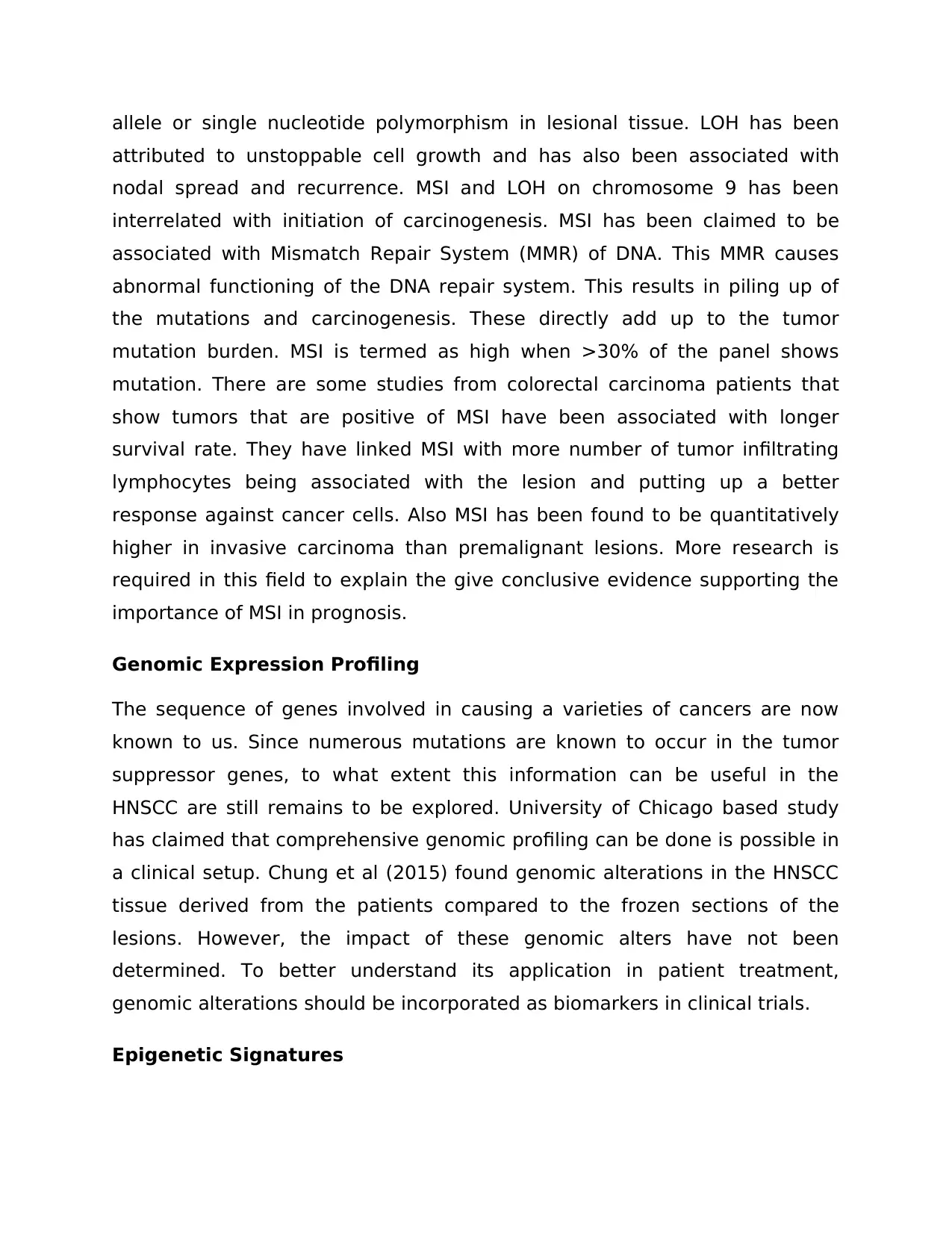
allele or single nucleotide polymorphism in lesional tissue. LOH has been
attributed to unstoppable cell growth and has also been associated with
nodal spread and recurrence. MSI and LOH on chromosome 9 has been
interrelated with initiation of carcinogenesis. MSI has been claimed to be
associated with Mismatch Repair System (MMR) of DNA. This MMR causes
abnormal functioning of the DNA repair system. This results in piling up of
the mutations and carcinogenesis. These directly add up to the tumor
mutation burden. MSI is termed as high when >30% of the panel shows
mutation. There are some studies from colorectal carcinoma patients that
show tumors that are positive of MSI have been associated with longer
survival rate. They have linked MSI with more number of tumor infiltrating
lymphocytes being associated with the lesion and putting up a better
response against cancer cells. Also MSI has been found to be quantitatively
higher in invasive carcinoma than premalignant lesions. More research is
required in this field to explain the give conclusive evidence supporting the
importance of MSI in prognosis.
Genomic Expression Profiling
The sequence of genes involved in causing a varieties of cancers are now
known to us. Since numerous mutations are known to occur in the tumor
suppressor genes, to what extent this information can be useful in the
HNSCC are still remains to be explored. University of Chicago based study
has claimed that comprehensive genomic profiling can be done is possible in
a clinical setup. Chung et al (2015) found genomic alterations in the HNSCC
tissue derived from the patients compared to the frozen sections of the
lesions. However, the impact of these genomic alters have not been
determined. To better understand its application in patient treatment,
genomic alterations should be incorporated as biomarkers in clinical trials.
Epigenetic Signatures
attributed to unstoppable cell growth and has also been associated with
nodal spread and recurrence. MSI and LOH on chromosome 9 has been
interrelated with initiation of carcinogenesis. MSI has been claimed to be
associated with Mismatch Repair System (MMR) of DNA. This MMR causes
abnormal functioning of the DNA repair system. This results in piling up of
the mutations and carcinogenesis. These directly add up to the tumor
mutation burden. MSI is termed as high when >30% of the panel shows
mutation. There are some studies from colorectal carcinoma patients that
show tumors that are positive of MSI have been associated with longer
survival rate. They have linked MSI with more number of tumor infiltrating
lymphocytes being associated with the lesion and putting up a better
response against cancer cells. Also MSI has been found to be quantitatively
higher in invasive carcinoma than premalignant lesions. More research is
required in this field to explain the give conclusive evidence supporting the
importance of MSI in prognosis.
Genomic Expression Profiling
The sequence of genes involved in causing a varieties of cancers are now
known to us. Since numerous mutations are known to occur in the tumor
suppressor genes, to what extent this information can be useful in the
HNSCC are still remains to be explored. University of Chicago based study
has claimed that comprehensive genomic profiling can be done is possible in
a clinical setup. Chung et al (2015) found genomic alterations in the HNSCC
tissue derived from the patients compared to the frozen sections of the
lesions. However, the impact of these genomic alters have not been
determined. To better understand its application in patient treatment,
genomic alterations should be incorporated as biomarkers in clinical trials.
Epigenetic Signatures
Paraphrase This Document
Need a fresh take? Get an instant paraphrase of this document with our AI Paraphraser

Epigenetic alterations bring about a change in the cellular responses without
affecting the original genetic code. These alterations are in the form of
chemical additions that can switch on or switch off the genetic function. They
are capable of altering the tumor microenvironment in such a way that the
immune response to the cancer cells is reinstated. Drugs which have DNA
methyltransferase and histone deacetylase inhibitors incorporated can annul
the suppressive action on immunoregulatory cells as well as enhance the
expression of tumor associated antigens and attenuated immune checkpoint
blockade. Research in lung cancer patients shows that the hypo-methylation
of the CTLA-4, and PD-1 promoter regions may be associated with increased
response of the associated genes in the tumor microenvironment. (Darvin,
Toor, Nair & Elkord, 2018). Thus, the potential role of epigenetic therapy
combined with immunotherapy through its prospective role in immune
checkpoint inhibition can immensely improve the prognosis of patients.
MicroRNAs
MicroRNAs (miRNA) are a family of small, non-coding, endogenously
synthesized, single-strand RNAs which are responsible for post-
transcriptional regulation of mRNA. MicroRNA via their contribution in
regulation of mRNA expression perform an essential role in differentiation of
cells, multoplication, apoptosis, and carcinogenesis. They are small strands
of non coding RNA. Since they can be easily studies even from the plasma,
they have a potential of becoming promising non-invasive biomarkers.
However, research still falls short of being ample in describing their role
either as predictive or prognostic biomarker or both for HNSCC treatment.
Conclusion
With all the knowledge of tumor immunology, checkpoint inhibitors offer a
promising role in the field of cancer immunotherapy. With these alternative
treatment options, the adverse effects related to the conventional chemo
radiotherapy can be avoided to a large extent and even the advanced cases
affecting the original genetic code. These alterations are in the form of
chemical additions that can switch on or switch off the genetic function. They
are capable of altering the tumor microenvironment in such a way that the
immune response to the cancer cells is reinstated. Drugs which have DNA
methyltransferase and histone deacetylase inhibitors incorporated can annul
the suppressive action on immunoregulatory cells as well as enhance the
expression of tumor associated antigens and attenuated immune checkpoint
blockade. Research in lung cancer patients shows that the hypo-methylation
of the CTLA-4, and PD-1 promoter regions may be associated with increased
response of the associated genes in the tumor microenvironment. (Darvin,
Toor, Nair & Elkord, 2018). Thus, the potential role of epigenetic therapy
combined with immunotherapy through its prospective role in immune
checkpoint inhibition can immensely improve the prognosis of patients.
MicroRNAs
MicroRNAs (miRNA) are a family of small, non-coding, endogenously
synthesized, single-strand RNAs which are responsible for post-
transcriptional regulation of mRNA. MicroRNA via their contribution in
regulation of mRNA expression perform an essential role in differentiation of
cells, multoplication, apoptosis, and carcinogenesis. They are small strands
of non coding RNA. Since they can be easily studies even from the plasma,
they have a potential of becoming promising non-invasive biomarkers.
However, research still falls short of being ample in describing their role
either as predictive or prognostic biomarker or both for HNSCC treatment.
Conclusion
With all the knowledge of tumor immunology, checkpoint inhibitors offer a
promising role in the field of cancer immunotherapy. With these alternative
treatment options, the adverse effects related to the conventional chemo
radiotherapy can be avoided to a large extent and even the advanced cases
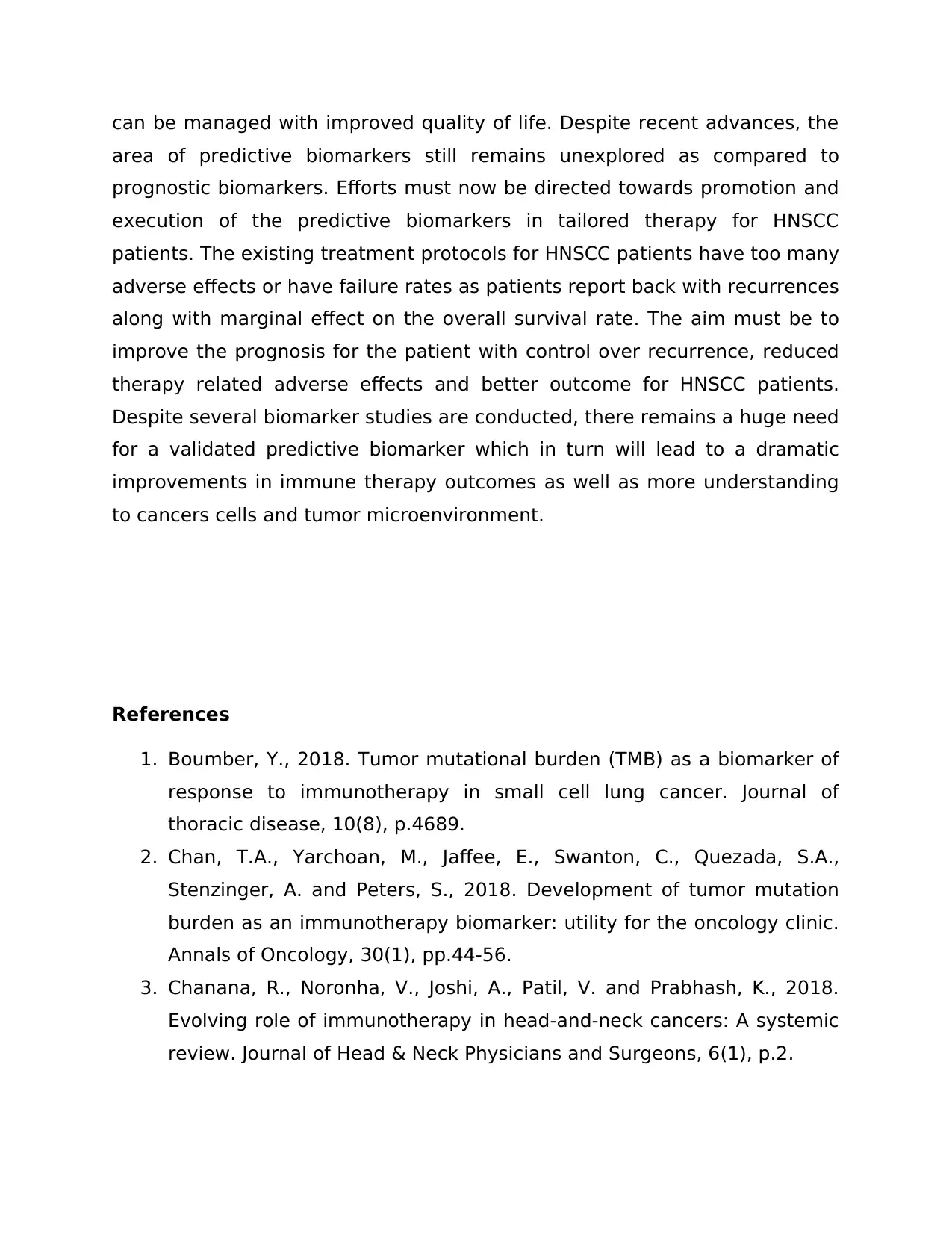
can be managed with improved quality of life. Despite recent advances, the
area of predictive biomarkers still remains unexplored as compared to
prognostic biomarkers. Efforts must now be directed towards promotion and
execution of the predictive biomarkers in tailored therapy for HNSCC
patients. The existing treatment protocols for HNSCC patients have too many
adverse effects or have failure rates as patients report back with recurrences
along with marginal effect on the overall survival rate. The aim must be to
improve the prognosis for the patient with control over recurrence, reduced
therapy related adverse effects and better outcome for HNSCC patients.
Despite several biomarker studies are conducted, there remains a huge need
for a validated predictive biomarker which in turn will lead to a dramatic
improvements in immune therapy outcomes as well as more understanding
to cancers cells and tumor microenvironment.
References
1. Boumber, Y., 2018. Tumor mutational burden (TMB) as a biomarker of
response to immunotherapy in small cell lung cancer. Journal of
thoracic disease, 10(8), p.4689.
2. Chan, T.A., Yarchoan, M., Jaffee, E., Swanton, C., Quezada, S.A.,
Stenzinger, A. and Peters, S., 2018. Development of tumor mutation
burden as an immunotherapy biomarker: utility for the oncology clinic.
Annals of Oncology, 30(1), pp.44-56.
3. Chanana, R., Noronha, V., Joshi, A., Patil, V. and Prabhash, K., 2018.
Evolving role of immunotherapy in head-and-neck cancers: A systemic
review. Journal of Head & Neck Physicians and Surgeons, 6(1), p.2.
area of predictive biomarkers still remains unexplored as compared to
prognostic biomarkers. Efforts must now be directed towards promotion and
execution of the predictive biomarkers in tailored therapy for HNSCC
patients. The existing treatment protocols for HNSCC patients have too many
adverse effects or have failure rates as patients report back with recurrences
along with marginal effect on the overall survival rate. The aim must be to
improve the prognosis for the patient with control over recurrence, reduced
therapy related adverse effects and better outcome for HNSCC patients.
Despite several biomarker studies are conducted, there remains a huge need
for a validated predictive biomarker which in turn will lead to a dramatic
improvements in immune therapy outcomes as well as more understanding
to cancers cells and tumor microenvironment.
References
1. Boumber, Y., 2018. Tumor mutational burden (TMB) as a biomarker of
response to immunotherapy in small cell lung cancer. Journal of
thoracic disease, 10(8), p.4689.
2. Chan, T.A., Yarchoan, M., Jaffee, E., Swanton, C., Quezada, S.A.,
Stenzinger, A. and Peters, S., 2018. Development of tumor mutation
burden as an immunotherapy biomarker: utility for the oncology clinic.
Annals of Oncology, 30(1), pp.44-56.
3. Chanana, R., Noronha, V., Joshi, A., Patil, V. and Prabhash, K., 2018.
Evolving role of immunotherapy in head-and-neck cancers: A systemic
review. Journal of Head & Neck Physicians and Surgeons, 6(1), p.2.
⊘ This is a preview!⊘
Do you want full access?
Subscribe today to unlock all pages.

Trusted by 1+ million students worldwide
1 out of 16
Related Documents
Your All-in-One AI-Powered Toolkit for Academic Success.
+13062052269
info@desklib.com
Available 24*7 on WhatsApp / Email
![[object Object]](/_next/static/media/star-bottom.7253800d.svg)
Unlock your academic potential
Copyright © 2020–2025 A2Z Services. All Rights Reserved. Developed and managed by ZUCOL.




